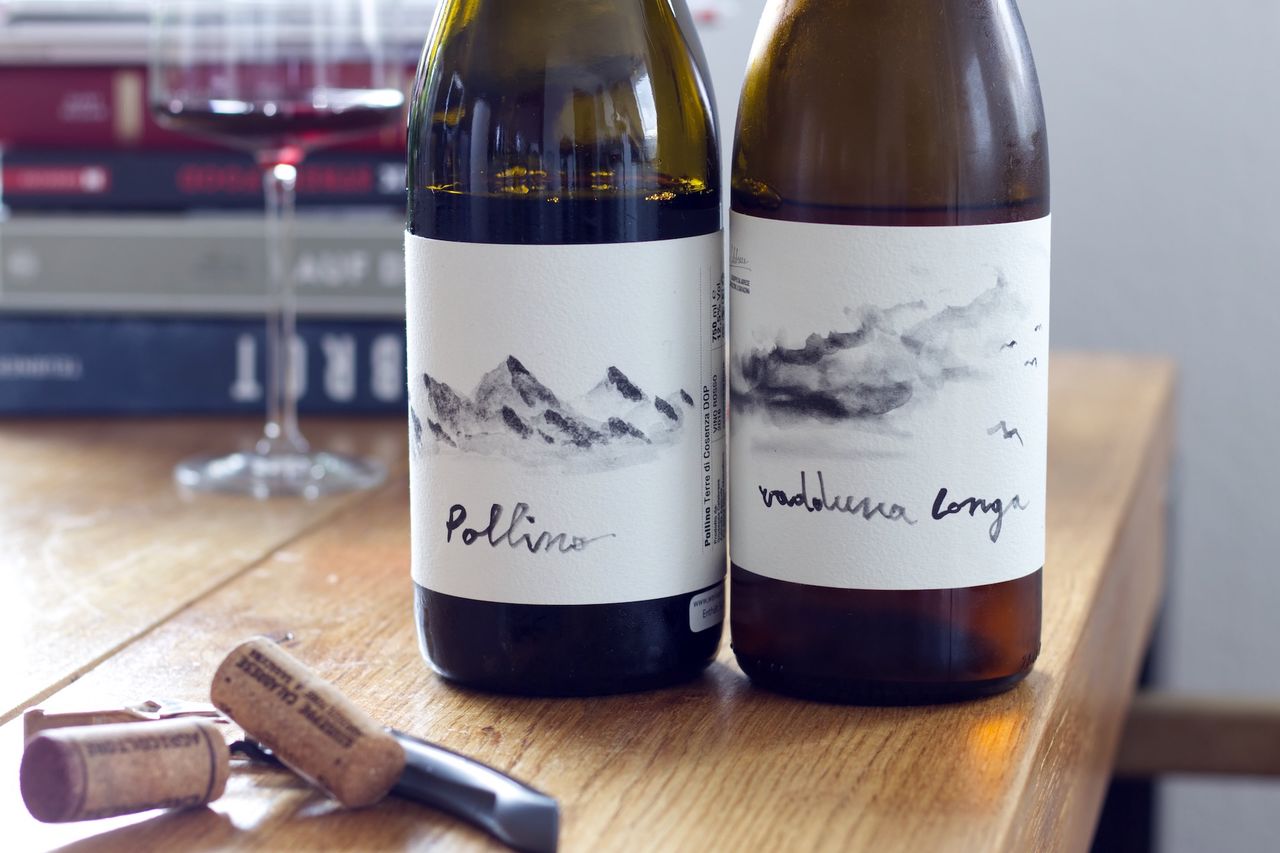Two Bottles Giuseppe Calabrese
We drink in the small Italy series two wines from Calabria by Giuseppe Calabrese: A Vadduna Longa 2020 and a Pollino 2016.

It continues in the small Italy series with grape varieties that I have never had before in the glass and wines that I would buy only because of the labels. And yet, with these two bottles, I can even surpass the pure label buyer reason in absurdity and come up with what is certainly the most barmy reason to buy wine so far. It is not quite a year ago that last summer in Karlsruhe at Das Fest, great festival by the way, the exceptional formation Roy Biance and the Abbrunzati Boys with their Italoschlager and a lot of Amore drilled into my musical heart. So it was inevitable that when I stumbled upon wines from Cosenza, as a true Tifosi, of course I could not say no. Because although in Cosenza the good does not have it easy (Attention, if you click on the link, there is a risk of being pulled quite deep into the Schlager whirlpool, although probably its even more weird for non-german speakers), I had a desire for the wines from Calabria. In fact, the first wines from Calabria for us and, of course, again two grape varieties never seen by our glasses before. A perfect fit for this series it is. Giuseppe Calabrese, how perfect is this name, makes wine near Saracena, north of Cosenza, somewhere between tip and heel of the italian boot. The vines grow here on limestone soil about 350 to 400 meters above sea level. The 2020 Vadduna Longa is made from the Guarnaccia variety, left on the skins for a day with the stems and stalks, and then left on the lees for six months. The Pollino is a single varietal Maggliocco Dolce, left on the skins for six days, then in stainless steel for a year and then in bottle for another 15 months before being put on sale. Since I have not even heard both grape varieties before, I naturally lack any comparative value. Comparing labels, however, is something I can do, and, as previously written, these very labels are quite beautiful.
When I pour the wine, I am briefly startled by the color of the Vadduna Longa. It’s quite dark in the glass and strongly reminiscent of sherry. And also on the nose, it’s quite special but at the same time enormously exciting. The nutty, yeasty and also stony nose is really fun. There is also fruit somewhere in between, but only in hints and not really assignable. And what then arrives on the tongue in terms of acidity, first brings a lot of freshness until the texture then claws far back on the tongue. This lives just as much from the mouthfeel as it does from the smell. This is soft and straight at the same time, exciting and very unexpected.
A day later, the wine is even more difficult to grasp. It has become more herbal and somehow also a bit fruitier. But which fruit is there, we are both over questioned. What is not in question at all, however, is the juiciness that the wine has developed in the meantime. How fresh that is, how that pulls, how velvety that is and how the acidity reminiscent of grapefruit keeps cutting through the rest. Very strong. In the empty glass, it smells a bit like pineapple and in general, it’s always a pretty good sign for me when interesting things can still be smelled in the empty glass.
Purely out of interest how stable it is a small remainder manages to wait two more days in the refrigerator. And what can I say, it has not harmed it at all. On the contrary, this is still really nice. The nose already quite oxidative, hardly any fruit, rather savory, but just with this freshness on the tongue and this clarity. Very peculiar, very special and certainly sometimes difficult to communicate. But also pretty amazing.
The Pollino also has a bit of nuttiness. In addition, red, very dry fruit, herbs and also something floral. This is intense and somehow fine and fragile at the same time. On the tongue then very cool with fine, soft tannin, which then with oxygen when slurping dries out the mouth quite quickly. Here you have in the empty glass then mainly spice, somehow umami with fresh mushrooms and herbs. I like the contrast, the freshness on the tongue, the dried fruit in the nose. Lots to discover there.
The wine then hardly changes overnight. We recently had Portugieser from Durst again, and urely on the feel of the wines, they are quite similar. Not so much in aromatics, but how quiet and deep this is, how fine, how complex, how much you can find if you look. Very close indeed. This is fresh, clear and at the same time has real grip and power. Wines that I didn’t have on the menu at all and am now glad they found their way here to the table.